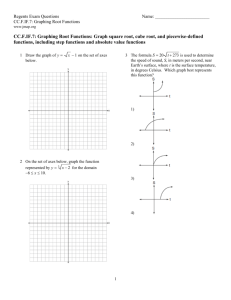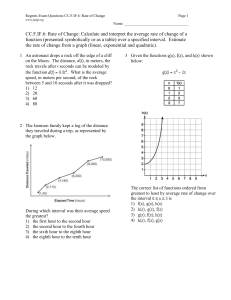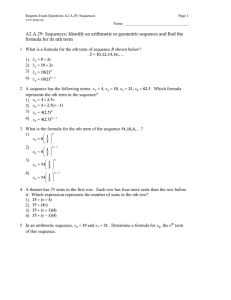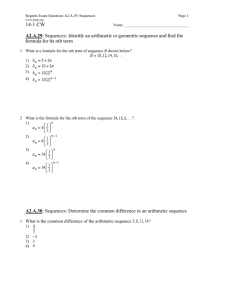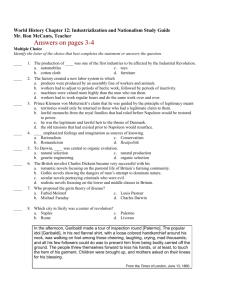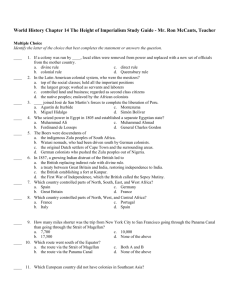World History Chapter 8: The Muslim Empires Study Guide
advertisement
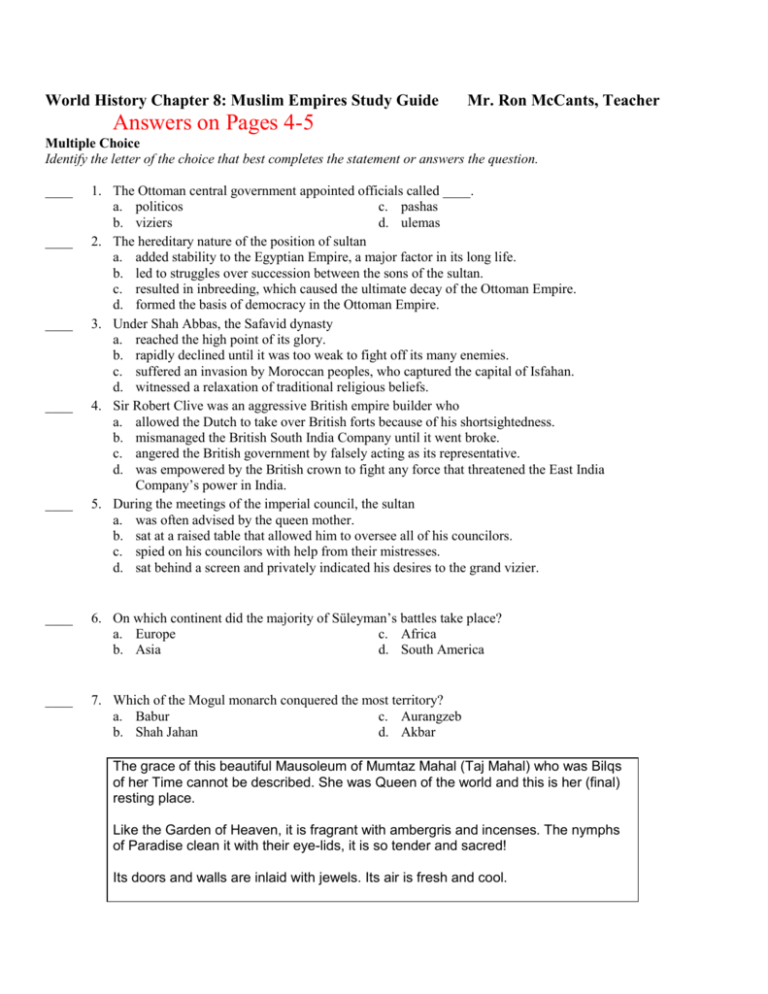
World History Chapter 8: Muslim Empires Study Guide Mr. Ron McCants, Teacher Answers on Pages 4-5 Multiple Choice Identify the letter of the choice that best completes the statement or answers the question. ____ ____ ____ ____ ____ 1. The Ottoman central government appointed officials called ____. a. politicos c. pashas b. viziers d. ulemas 2. The hereditary nature of the position of sultan a. added stability to the Egyptian Empire, a major factor in its long life. b. led to struggles over succession between the sons of the sultan. c. resulted in inbreeding, which caused the ultimate decay of the Ottoman Empire. d. formed the basis of democracy in the Ottoman Empire. 3. Under Shah Abbas, the Safavid dynasty a. reached the high point of its glory. b. rapidly declined until it was too weak to fight off its many enemies. c. suffered an invasion by Moroccan peoples, who captured the capital of Isfahan. d. witnessed a relaxation of traditional religious beliefs. 4. Sir Robert Clive was an aggressive British empire builder who a. allowed the Dutch to take over British forts because of his shortsightedness. b. mismanaged the British South India Company until it went broke. c. angered the British government by falsely acting as its representative. d. was empowered by the British crown to fight any force that threatened the East India Company’s power in India. 5. During the meetings of the imperial council, the sultan a. was often advised by the queen mother. b. sat at a raised table that allowed him to oversee all of his councilors. c. spied on his councilors with help from their mistresses. d. sat behind a screen and privately indicated his desires to the grand vizier. ____ 6. On which continent did the majority of Süleyman’s battles take place? a. Europe c. Africa b. Asia d. South America ____ 7. Which of the Mogul monarch conquered the most territory? a. Babur c. Aurangzeb b. Shah Jahan d. Akbar The grace of this beautiful Mausoleum of Mumtaz Mahal (Taj Mahal) who was Bilqs of her Time cannot be described. She was Queen of the world and this is her (final) resting place. Like the Garden of Heaven, it is fragrant with ambergris and incenses. The nymphs of Paradise clean it with their eye-lids, it is so tender and sacred! Its doors and walls are inlaid with jewels. Its air is fresh and cool. The clouds of the grace of God always shower on this sacred sepulcher. It is the place where everybody's prayers are accepted (by God). It is a monument of sorrow. Everybody who goes to see it feel its grief. Even the Sun and the Moon shed tears on it. This lofty building fulfills needs of everybody without discrimination like the Sun (who bestows its light upon all, in general). Shah Jahan, 1631 ____ 8. Based on the information in this passage, what is the best definition of the word sepulcher? a. burial vault c. dome b. incense d. fountain The janissary corps were the elite soldiers and administrators of the sultan’s army. They were young Christian boys chosen because of their “good appearance and good physical build.” This policy of recruiting janissaries lasted until 1634. After 1634, new recruits came from the sons of janissaries and were less disciplined. To minimize the impact on the Ottoman treasury, the janissaries took jobs in the winter (when they were usually not fighting) as artisans. By 1826, the janissary force had grown so large—135,000 strong—and so powerful that the sultan was forced to massacre all its members. The demise of the janissaries corresponded with the decline of the Ottoman Empire. ____ 9. During the winter, the janissaries ____. a. worked in the ruling class b. worked as peasants c. worked as merchants d. worked as artisans In 1507, Safavid ruler Shah Ismail began raiding Ottoman lands in eastern Asia Minor, antagonizing the Ottomans and making future conflict between the two empires inevitable. Tensions reached their height in 1514, and the two armies met in August of that year in Chaldiran. The Ottomans, the first Islamic empire to employ artillery in warfare, completely decimated the Safavid cavalry. Ismail withdrew his troops and the Ottoman Sultan, Selim I, did not pursue him. Following the battle, the Safavid capital was moved from Tabriz to Qazvin. The battle also established the border between the two empires, which remains the border between Turkey and Iran today. ____ 10. Where did the Ottoman and Safavid armies meet in the year 1514? a. Tabriz c. Istanbul b. Qazvin d. Chaldiran Completion Complete each sentence or statement. 11. The Bosporus and the Dardanelles are separated by the ____________________. 12. Constantinople was later renamed ____________________. 13. The Ottoman advance into Europe was halted at ____________________, where the Ottoman soldiers were defeated in 1529. 14. The ____________________ was the residence of the sultan and his wives. 15. Pressure to conform to traditional religious beliefs, or religious ____________________, increased under the Safavids. 16. After the death of ____________________, the Safavid dynasty gradually lost its vigor. 17. The Mogul leader, Babur, was descended from both Timur Lenk and ____________________. 18. ____________________ made successful campaigns in the Deccan Plateau and against Samarkand. 19. In India, the practice of ____________________ required a widow to be cremated along with her husband. 20. The British established trading forts in India at Calcutta and ____________________. Matching Match each item with the correct statement below. a. Mogul f. b. grand vizier g. c. “Akbar style” h. d. Mehmet II i. e. Akbar j. ____ ____ ____ ____ ____ ____ ____ ____ ____ ____ 21. 22. 23. 24. 25. 26. 27. 28. 29. 30. Safavid Sinan Riza-i-Abbasi zamindar “gunpowder empires” the greatest of all Ottoman architects under his leadership, the Ottomans conquered Constantinople empires formed by outside conquerors who unified the regions they conquered sultan’s chief minister dynasty founded by Shah Ismail famous painter of the Safavid Era dynasty that unified the subcontinent of India in the 1600s expanded his empire to rule almost all of India local Mogul official who kept part of the taxes in lieu of a salary combined Persian with Indian motifs World History Chapter 8: Muslim Empires Study Guide Answer Section Mr. Ron McCants, Teacher MULTIPLE CHOICE 1. ANS: C DIF: A 2. ANS: B DIF: C STO: WH9.EHPS11 3. ANS: A DIF: A 4. ANS: D DIF: A 5. ANS: D DIF: E STO: WH9.EHPS11 6. ANS: A DIF: A STO: WH9.EHPS11 7. ANS: D DIF: C MSC: Document Based Question 8. ANS: A DIF: A MSC: Document Based Question 9. ANS: D DIF: E STO: WH9.EHPS11 10. ANS: D DIF: A STO: WH9.EHPS11 REF: Page 241 STO: WH9.EHPS11 REF: Pages 242-243 REF: Page 251 STO: WH9.EHPS11 REF: Page 258 STO: WH9.EHPS11 REF: Pages 242-243 REF: Pages 246-249 MSC: Document Based Question REF: Page 256 STO: WH9.EHPS11 REF: Pages 259-260 REF: MSC: REF: MSC: Pages 242-243 Document Based Question Pages 240-253 Document Based Question COMPLETION 11. ANS: Sea of Marmara DIF: A 12. ANS: Istanbul REF: Page 240 DIF: E 13. ANS: Vienna REF: Page 241 DIF: E 14. ANS: harem REF: Page 242 DIF: A 15. ANS: orthodoxy REF: Page 243 DIF: E 16. ANS: Shah Abbas REF: Page 251 STO: WH9.EHPS11 DIF: A REF: Page 251 17. ANS: Genghis Khan STO: WH9.EHPS11 DIF: C 18. ANS: Shah Jahan REF: Pages 255-256 STO: WH9.EHPS11 STO: WH9.EHPS11 DIF: A 19. ANS: suttee REF: Page 257 DIF: A 20. ANS: Chennai REF: Page 259 DIF: A STO: WH9.EHPS11 REF: Pages 257-258 STO: WH9.EHPS11 MATCHING 21. ANS: G DIF: 22. ANS: D DIF: STO: WH9.EHPS11 23. ANS: J DIF: 24. ANS: B DIF: 25. ANS: F DIF: 26. ANS: H DIF: 27. ANS: A DIF: STO: WH9.EHPS11 28. ANS: E DIF: 29. ANS: I DIF: 30. ANS: C DIF: A A REF: Page 245 REF: Pages 240-241 E A A A A REF: REF: REF: REF: REF: A A E REF: Page 256 REF: Page 256 REF: Page 260 Back to www.ChaplainRon.com/HighSchool Page 242 STO: WH9.EHPS11 Page 243 STO: WH9.EHPS11 Page 250 STO: WH9.EHPS11 Page 253 Pages 255-256 STO: WH9.EHPS11 STO: WH9.EHPS11




